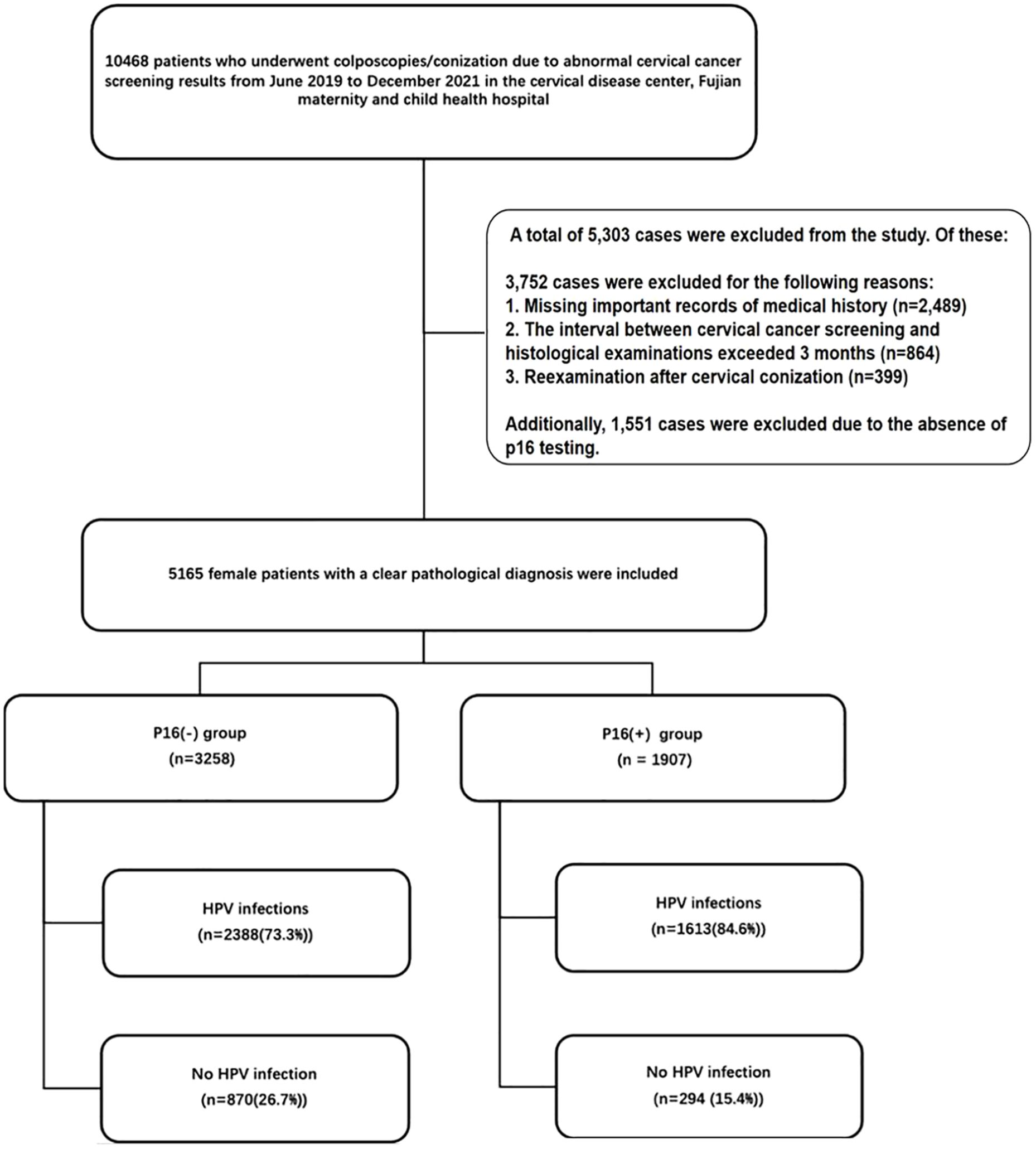- 1Department of Gynecology, Fujian Maternity and Child Health Hospital College of Clinical Medical for Obstetrics & Gynecology and Pediatrics, Fujian Medical University, Fuzhou, China
- 2Division of Birth Cohort Study, Fujian Maternity and Child Health Hospital, College of Clinical Medicine for Obstetrics & Gynecology and Pediatrics, Fujian Medical University, Fuzhou, China
- 3Integrated Biology, University of California, Berkeley, Berkeley, CA, United States
- 4Cervical Disease Diagnosis and Treatment Health Center, Fujian Maternity and Child Health Hospital College of Clinical Medical for Obstetrics & Gynecology and Pediatrics, Fujian Medical University, Fuzhou, China
By Zhang Y, Li H, Li X, Li Z, You Q, Liu H, Zhao Z, Su Y, Zheng X, Chen Y, Chen J and Yi H (2023) Front. Oncol. 13:1265726. doi: 10.3389/fonc.2023.1265726
In the published article, there was an error in the legend for Figure 1 as published.

Figure 1. Out of a total of 10,468 patients who underwent colposcopies/conization due to abnormal cervical cancer screening results from June 2019 to December 2021, 5,303 cases were excluded. Of these, 3,752 cases were excluded for the following reasons: 1. Missing important records of medical history (n=2,489). 2. The interval between cervical cancer screening and histological examinations exceeded 3 months (n=864). 3. Reexamination after cervical conization (n=399). Additionally, 1,551 cases were excluded due to the absence of p16 testing. A total of 5,165 female patients with clear pathological diagnoses were included in the final analysis. HPV, human papillomavirus.
The corrected Figure 1 legend appears below:
“Out of a total of 10,468 patients who underwent colposcopies/conization due to abnormal cervical cancer screening results from June 2019 to December 2021, 5,303 cases were excluded. Of these, 3,752 cases were excluded for the following reasons:
1. Missing important records of medical history (n=2,489).
2. The interval between cervical cancer screening and histological examinations exceeded 3 months (n=864).
3. Reexamination after cervical conization (n=399).
Additionally, 1,551 cases were excluded due to the absence of p16 testing.
A total of 5,165 female patients with clear pathological diagnoses were included in the final analysis. HPV, human papillomavirus.”
The authors apologize for this error and state that this does not change the scientific conclusions of the article in any way. The original article has been updated.
Publisher’s note
All claims expressed in this article are solely those of the authors and do not necessarily represent those of their affiliated organizations, or those of the publisher, the editors and the reviewers. Any product that may be evaluated in this article, or claim that may be made by its manufacturer, is not guaranteed or endorsed by the publisher.
Keywords: HPV, cervical cancer, p16, cervical lesions, retrospective study
Citation: Zhang Y, Li H, Li X, Li Z, You Q, Liu H, Zhao Z, Su Y, Zheng X, Chen Y, Chen J and Yi H (2025) Corrigendum: Associations of multi-human papillomavirus infections with expression of p16 in a cohort of women who underwent colposcopy: a retrospective study of 5165 patients. Front. Oncol. 15:1570236. doi: 10.3389/fonc.2025.1570236
Received: 03 February 2025; Accepted: 17 February 2025;
Published: 07 March 2025.
Edited and Reviewed by:
Songlin Zhang, Baylor College of Medicine, United StatesCopyright © 2025 Zhang, Li, Li, Li, You, Liu, Zhao, Su, Zheng, Chen, Chen and Yi. This is an open-access article distributed under the terms of the Creative Commons Attribution License (CC BY). The use, distribution or reproduction in other forums is permitted, provided the original author(s) and the copyright owner(s) are credited and that the original publication in this journal is cited, in accordance with accepted academic practice. No use, distribution or reproduction is permitted which does not comply with these terms.
*Correspondence: Yanzhao Su, c3V5YW56aGFvNjA5QDE2My5jb20=; Xiangqin Zheng, Wmhlbmd4cTEyMTVAMTYzLmNvbQ==; Huan Yi, eWlodWFuZ3Nya0AxMjYuY29t
†These authors have contributed equally to this work and share first authorship
 Yulong Zhang
Yulong Zhang Haibo Li2†
Haibo Li2† Huan Yi
Huan Yi